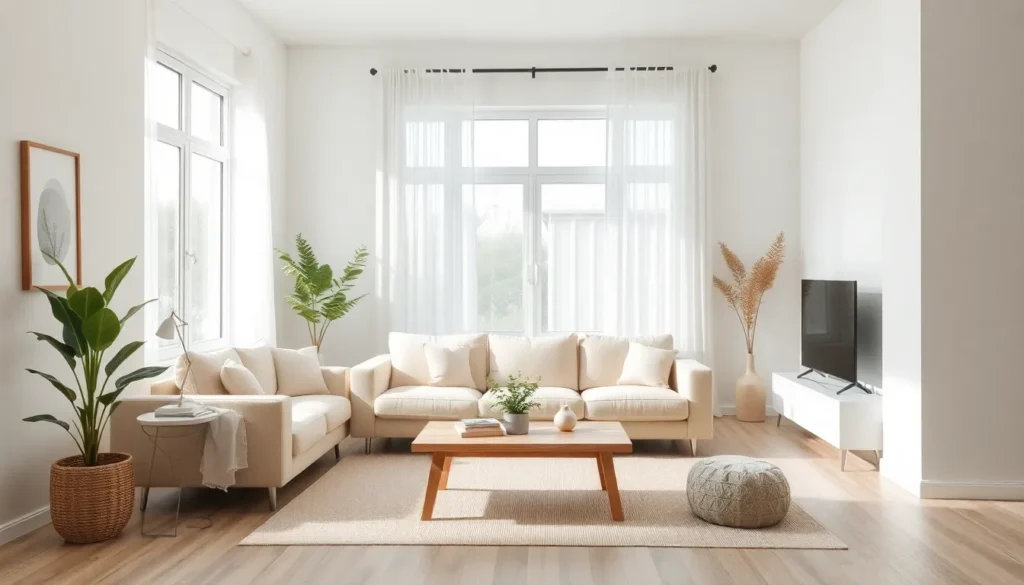In a world buzzing with chaos and clutter, minimalist decor emerges like a breath of fresh air, inviting serenity into homes. Imagine a space where every item has a purpose, and every corner whispers calm. It’s not just about less stuff; it’s about more life. Who wouldn’t want to swap out the clutter for a clean, chic aesthetic that feels like a spa retreat?
Table of Contents
ToggleWhat Is Minimalist Decor?
Minimalist decor emphasizes simplicity and functionality in design. It involves using fewer elements to create a cohesive and harmonious space. Clean lines, open spaces, and a limited color palette characterize it. Neutral tones dominate, with whites, grays, and earth tones promoting tranquility.
Functional furniture serves a dual purpose. Each piece often provides storage, reducing clutter and enhancing organization. Decor items are minimal and intentional, highlighting quality over quantity. Artworks or decorative pieces tend to be bold and significant rather than numerous.
Less can indeed be more in a minimalist environment. Serenity in design forms the foundation of minimalist decor, allowing individuals to focus better on what’s important. Spaces appear uncluttered, fostering a sense of calm and clarity.
Sustainability plays a role in minimalist decor. Choosing sustainable materials not only contributes to a serene aesthetic but also reflects a mindful lifestyle. Prioritizing eco-friendly products supports the overall philosophy of minimalism.
Functionality and aesthetic seamlessly intertwine in minimalist spaces. Every design choice aligns with purpose, leading to environments that cater to relaxation and productivity. This thoughtful approach results in homes that feel open, inviting, and purposeful, akin to a spa retreat.
Key Elements of Minimalist Decor

Minimalist decor thrives on simplicity and intentionality. Key elements create inviting and functional spaces that promote relaxation and clarity.
Color Palette
Neutral tones dominate the color palette in minimalist decor. Shades like whites, beiges, and soft grays create a calming atmosphere. Darker accents provide contrast without overwhelming the space. A cohesive color scheme enhances visual harmony, making rooms feel larger and more open. Monochromatic designs often emphasize textures over colors. Such palettes support a serene aesthetic, contributing to a spa-like environment.
Furniture Selection
Functional furniture plays a vital role in minimalist decor. Pieces often serve dual purposes, such as a coffee table that doubles as storage. Clean lines and sleek designs enhance visual appeal while maintaining practicality. Avoiding ornate details fosters an uncluttered look. Essential items are prioritized over decorative ones, ensuring each piece adds value. Resilient materials that support sustainability align with the minimalist ethos.
Decorative Accessories
Decorative accessories in minimalist spaces prioritize quality and intention. Fewer, well-chosen items create focal points without cluttering surfaces. Textiles such as throws and cushions introduce warmth while remaining understated. Art pieces often showcase simple designs that resonate with the overall theme. Natural elements like plants can add life while enhancing air quality. Thoughtful integration of accessories reinforces the principles of minimalism while creating inviting environments.
Benefits of Minimalist Decor
Minimalist decor offers various advantages, enhancing both aesthetics and functionality in living spaces.
Enhanced Aesthetics
Minimalist decor creates an inviting and serene visual appeal. Clean lines and a limited color palette promote a calming atmosphere. Neutral tones often dominate the design, fostering harmony and balance. Each piece serves a purpose, drawing attention without overwhelming the senses. Items chosen for their quality enhance the overall aesthetic while ensuring intentionality. Ambiance improves when fewer decor elements elevate the visual impact. Spaces feel larger and more open, allowing for a sense of freedom. The simplicity of minimalist design invites relaxation and promotes clarity in thought.
Improved Functionality
Functionality stands at the core of minimalist decor principles. Furniture is often designed for multiple uses, providing storage solutions that reduce clutter. Intentional spaces free from unnecessary items enhance organization and workflow. The absence of chaos facilitates easier navigation, allowing for better movement within a home. Natural materials frequently used in minimalist design support durability and sustainability. Simplified aesthetics enable individuals to focus on essential tasks, enhancing productivity. Overall, thoughtful arrangements contribute to an efficient lifestyle, prioritizing usability without sacrificing style.
Tips for Achieving Minimalist Decor
Achieving minimalist decor involves thoughtful choices and intentionality in every element of a space. Implementing these strategies can enhance clarity and serenity in interiors.
Decluttering Your Space
Start by removing excess items that do not serve a purpose. Embrace the idea of keeping surfaces clear, which fosters a calm environment. Utilize storage solutions to conceal less frequently used items, helping to maintain an organized appearance. Regular assessments of possessions ensure only essential pieces remain visible. Invite simplicity into every room by focusing on open spaces, making areas feel larger and more inviting.
Choosing Quality Over Quantity
Selecting fewer, high-quality items will enhance the aesthetic appeal of a space. Prioritize durable materials to ensure longevity, which also contributes to sustainability. Invest in timeless furniture pieces that offer functionality while maintaining style. Thoughtful selection of decor items encourages a curated look, avoiding clutter and distractions. Each chosen item should resonate with personal taste and serve a specific purpose, reinforcing minimalist principles.
Incorporating Natural Light
Maximizing natural light can significantly elevate a room’s ambiance. Keep window treatments simple to allow ample sunlight to flood in. Mirrors can reflect light, making smaller spaces feel more expansive and bright. Opt for light paint colors to bounce natural light around the room, enhancing warmth and openness. Position furnishings strategically to avoid blocking windows, ensuring that light remains an integral part of the decor.
Embracing minimalist decor transforms living spaces into serene retreats that prioritize clarity and functionality. By focusing on quality over quantity and selecting intentional pieces, individuals can create environments that foster relaxation and productivity. The thoughtful integration of natural elements and a cohesive color palette enhances visual harmony while supporting a sustainable lifestyle.
Minimalism is more than a design choice; it’s a lifestyle that encourages mindfulness and intentional living. As spaces become less cluttered, individuals find room to breathe, think, and thrive. Adopting these principles not only enhances the aesthetic appeal of a home but also enriches daily life, making every moment feel more purposeful and fulfilling.



